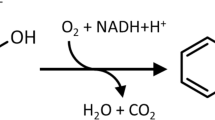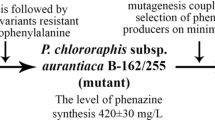Abstract
The biocatalytic conversion of 5-mono-substituted hydantoins to the corresponding d-amino acids or l-amino acids involves first the hydrolysis of hydantoin to a N-carbamoylamino acid by an hydantoinase or dihydropyrimidinase, followed by the conversion of the N-carbamoylamino acid to the amino acid by N-carbamylamino acid amidohydrolase (N-carbamoylase). Pseudomonas putida strain RU-KM3S, with high levels of hydantoin-hydrolysing activity, has been shown to exhibit non-stereoselective hydantoinase and l-selective N-carbamoylase activity. This study focused on identifying the hydantoinase and N-carbamoylase-encoding genes in this strain, using transposon mutagenesis and selection for altered growth phenotypes on minimal medium with hydantoin as a nitrogen source. Insertional inactivation of two genes, dhp and bup, encoding a dihydropyrimidinase and β-ureidopropionase, respectively, resulted in loss of hydantoinase and N-carbamoylase activity, indicating that these gene products were responsible for hydantoin hydrolysis in this strain. dhp and bup are linked to an open reading frame encoding a putative transport protein, which probably shares a promoter with bup. Two mutant strains were isolated with increased levels of dihydropyrimidinase but not β-ureidopropionase activity. Transposon mutants in which key elements of the nitrogen regulatory pathway were inactivated were unable to utilize hydantoin or uracil as a nitrogen source. However, these mutations had no effect on either the dihydropyrimidinase or β-ureidopropionase activity. Disruption of the gene encoding dihydrolipoamide succinyltransferase resulted in a significant reduction in the activity of both enzymes, suggesting a role for carbon catabolite repression in the regulation of hydantoin hydrolysis in P. putida RU-KM3S cells.








Similar content being viewed by others
References
Abendroth J, Niefind K, May O, Siemann M, Syltdatk C, Schomburg D (2002) The structure of l-hydantoinase from Arthrobacter aurescens leads to an understanding of dihydropyrimidinase substrate and enantio-specificity. Biochemistry 41:8589–8597
Ausubel FM, Brent R, Kingston RE, Moore DD, Seidman JG, Smith JA, Struhl K (1983) Current protocols in molecular biology, 3rd edn. Wiley, New York
Bommarius A, Scharm M, Drauz K (1998) Biocatalysis to amino acid-based chiral pharmaceuticals—examples and perspectives. J Mol Catal B Enzym 5:1–11
Buchanan K, Burton SG, Dorrington RA, Matcher GF, Skepu Z (2001) A novel Pseudomonas putida strain with high levels of hydantoin-converting activity, producing l-amino acids. J Mol Catal B Enzym 11:397–406
Burton SG, Dorrington RA, Hartley C, Kirchmann S, Matcher G, Phehane V (1998) Production of enantiomerically pure amino acids: characterization of South African hydantoinases and hydantoin-producing bacteria. J Mol Catal B Enzym 5:301–305
Buson A, Negro A, Grassato L, Taliaro M, Basaglia M, Grandi C, Fontana A, Nuti M (1996) Identification, sequencing and mutagenesis of the gene for d-carbamoylase from Agrobacterium radiobacter. FEMS Microbiol Lett 145:55–62
Chen H, Tsai H (1998) Cloning, sequencing, and expression in Escherichia coli of d-hydantoinase gene from Pseudomonas putida. Ann N Y Acad Sci 864:234–237
Cheon Y, Kim H, Han K, Abendroth J, Niefind K, Schomburg D, Wang J, Kim Y (2002) Crystal structure of d-hydantoinase from Bacillus stearothermophilus: an insight into stereochemistry of enantioselectivity. Biochemistry 41:9410–9417
Chien H, Jih Y, Yang W, Hsu W (1998) Identification of the open reading frame for the Pseudomonas putida d-hydantoinase gene and expression of the gene in Escherichia coli. Biochim Biophys Acta 1395:68–77
Collier DN, Hager PW, Phibbs PV (1996) Catabolite repression control in the pseudomonads. Res Microbiol 147:551–561
Dennis J, Zylstra G (1998) Plasposons: modular self-cloning minitransposon derivatives for rapid genetic analysis of gram-negative bacterial genomes. Appl Environ Microbiol 64:2710–2715
Eberl L, Ammendola A, Rothballer M, Givskov M, Sternberg C, Kilstrup M, Schleifer K, Molin S (2000) Inactivation of glnB abolishes expression of the assimilatory nitrate reductase gene (nasB) in Pseudomonas putida KT2442. J Bacteriol 182:3368–3376
Grifantini R, Galli G, Carpani G, Pratesi C, Frascotti G, Grandi G (1998) Efficient conversion of 5-substituted hydantoins to d-α-amino acids using recombinant Escherichia coli strains. Microbiology 144:947–954
Hartley CJ, Kirchmann S, Burton SG, Dorrington RA (1998) Production of d-amino acids from d,l-5-substituted hydantoins by an Agrobacterium tumefaciens strain and isolation of a mutant with inducer-independent expression of hydantoin-hydrolysing activity. Biotechnol Lett 20:707–711
Hartley CJ, Manford F, Burton SG, Dorrington RA (2001) Overproduction of hydantoinase and N-carbamoylase enzymes by regulatory mutants of Agrobacterium tumefaciens. Appl Microbiol Biotechnol 57:43–49
Hils M, Munch P, Altenbuchner J, Syldatk C, Mattes R (2001) Cloning and characterization of genes from Agrobacterium sp. IP I-671 involved in hydantoin degradation. Appl Microbiol Biotechnol 57:680–688
Ikenaka Y, Nanba H, Yamada Y, Yajima K, Takano M, Takahashi S (1998) Screening, characterization, and cloning of the gene for N-carbamyl-d-amino acid amidohydrolase from thermotolerant soil bacteria. Biosci Biotechnol Biochem 62:882–886
Ishikawa T, Watabe K, Mukohara Y, Nakamura H (1996) N-carbamyl-l-amino acid amidohydrolase of Pseudomonas sp. Strain NS671: purification and some properties of the enzyme expressed in Escherichia coli. Biosci Biotechnol Biochem 60:612–615
Janssen DB, Drift C van der (1983) Catabolite repression and nitrogen control of allantoin-degrading enzymes in Pseudomonas aeruginosa. Antonie Van Leeuwenhoek 49:501–508
Kim G, Park D, Lee H, Ro H, Kim H (1997) Primary structure, sequence analysis and expression of the thermostable d-hydantoinase from Bacillus stearothermophilus SD-1. Mol Gen Genet 255:152–156
LaPointe G, Viau S, Leblanc D, Robert N, Morin A (1994) Cloning, sequencing, and overexpression in Escherichia coli of the d-hydantoinase gene from Pseudomonas putida and distribution of homologous genes in other microorganisms. Appl Environ Microbiol 60:888–895
Merrick M, Edwards R (1995) Nitrogen control in bacteria. Microbiol Rev 59:604–622
Michal G (1999) Biochemical pathways—an atlas of biochemistry and molecular biology. Wiley, New York
Miller J (1992) A short course in bacterial genetics: a laboratory manual and handbook for Escherichia coli and related bacteria. Cold Spring Harbor Laboratory, Cold Spring Harbor, N.Y.
Mukohara Y, Ishikawa T, Watabe K, Nakamura H (1994) A thermostable hydantoinase of Bacillus stearothermophilus NS1122A: cloning, sequencing and high expression of the enzyme gene, and some properties of the expressed enzyme. Biosci Biotechnol Biochem 58:1621–1626
Ogawa J, Shimizu S (1997) Diversity and versatility of microbial hydantoin-transforming enzymes. J Mol Catal B Enzym 2:163–176
Oh K, Nam S, Kim H (2002) Improvement of oxidative and thermostability of N-carbamyl-d-amino acid amidohydrolase by directed evolution. Protein Eng 15:689–695
Palmer JA, Hatter K, Sokatch JR (1991) Cloning and sequence analysis of the LPD-glc structural gene of Pseudomonas putida. J Bacteriol 173:3109–3116
Sambrook J, Fritsch EF, Maniatis T (1989) Molecular cloning, 2nd edn. Cold Spring Harbor Laboratory, Cold Spring Harbor, N.Y.
Syldatk C, Pietzsch M (1995) Hydrolysis and formation of hydantoins. In: Drauz K, Waldmann H (eds) Enzyme catalysis in organic synthesis. VCH, Weinheim, pp 409–431
Watabe K, Ishikawa T, Mukohara Y, Nakamura H (1992) Cloning and sequencing of the genes involved in the conversion of 5-substituted hydantoins to the corresponding l-amino acids from the native plasmid of Pseudomonas sp. strain NS671. J Bacteriol 174:962–969
Wiese A, Syldatk C, Mattes R, Altenbuchner J (2001) Organisation of genes responsible for the stereospecific conversion of hydantoins to α-amino acids in Arthrobacter aurescens DSM 3747. Arch Microbiol 176:187–196
Acknowledgements
This research was funded by Innovation Fund Grant No. 141141; and G.F.M. was supported by a Rhodes University Henderson Scholarship. The authors wish to acknowledge J.J. Dennis and G. Zylstra for kindly supplying the plasposon vectors, C.J. Hartley, S.A. Clark, and C. Louw for technical assistance, and members of the Rhodes Hydantoinase Research Group for stimulating discussion and constructive advice. The research described in this study was conducted in compliance with the Genetically Modified Organisms Act 15 of 1997[/Sapl4] of South Africa.
Author information
Authors and Affiliations
Corresponding author
Rights and permissions
About this article
Cite this article
Matcher, G.F., Burton, S.G. & Dorrington, R.A. Mutational analysis of the hydantoin hydrolysis pathway in Pseudomonas putida RU-KM3S . Appl Microbiol Biotechnol 65, 391–400 (2004). https://doi.org/10.1007/s00253-004-1597-3
Received:
Revised:
Accepted:
Published:
Issue Date:
DOI: https://doi.org/10.1007/s00253-004-1597-3




